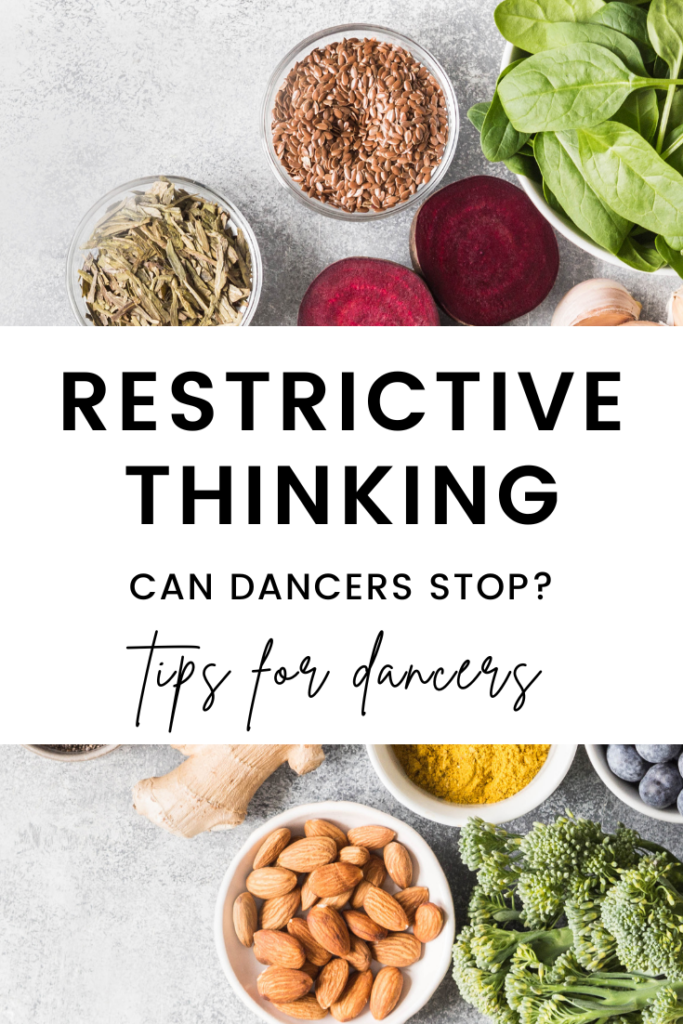What are restrictive food thoughts?
Food thoughts bear a heavy impact on our relationships with food. Feelings like “I shouldn’t be eating this” and “I’m so bad for wanting this!” often come alongside food guilt, paving the way for challenging eating experiences. If you’ve ever ridiculed yourself for eating “too much” and/or eating the “wrong” foods, then it’s possible that you’re struggling with restrictive food thoughts or restrictive thinking. Restrictive thinking is a type of food restriction that may or may not involve an actual caloric restriction or food avoidance.
For many dancers, restrictive thinking is the norm— the result of a looming dancer diet culture that polarizes foods into categories like “good,” “bad,” healthy, and unhealthy. Dancers are left with beliefs about how to supposedly eat less and “cleaner,” both of which are, of course, restrictions.
How can dancers stop restrictive food thoughts?
Before we can unravel restrictive food thoughts, it’s important to explore the ultimate goal of building a supportive relationship with food. Intuitive eating is a non-diet approach that prioritizes nourishment in the form of self-care, not self-control. And while, as a certified counselor of intuitive eating, I teach dancers how to integrate this tool into their daily lives, the ultimate result is often misunderstood.
Intuitive eating isn’t as carefree as social media makes it out to be. Similarly and unfortunately, stopping restrictive food thoughts isn’t a reality for most. Rather than focusing our efforts on eliminating them, we’re tackling how to respond to them in a more productive manner.
#1: Identification- what thoughts are restrictive?
I’ve previously discussed the benefits of labeling unsupportive thoughts (particularly in the context of body image). A similar approach can be used with restrictive food thoughts. As I discuss in this article, the food police represent these restrictive thoughts and oftentimes, is a helpful label for dancers working to identify them. A quick tip? Explore whether or not the thought (or belief) is causing you to feel doubtful at mealtimes. Some examples of restrictive food thoughts include:
10+ restrictive food thoughts every dancer needs to unravel
- I’ve eaten way too much!
- I feel so gross after eating that.
- I can only eat it if I work out for X amount of time.
- If I eat that now, I won’t be able to have it again for X amount of time.
- There are way too many calories in that!
- That’s very processed… if I eat it, I’ll have to stick to clean options tomorrow!
- That dessert looks good, but it’s not worth the calories or guilt.
- I shouldn’t be eating this!
- I need to eat super clean today.
- As a dancer, I should be eating more of [food X] and less of [food Y].
- I’ll just take a bite… it’s really not allowed on my meal plan.
#2: Decipher between food rules and food choices
This is a topic that I dive into here. Food rules are pre-conceived thoughts that stem from diet and wellness culture. Food choices, however, are supported by a multitude of reasons like past eating experiences and personal preferences. It can be challenging to decipher between the two.
Dancers might question whether or not their decision to eat a salad is rooted in a food rule or food choice. This is where intention matters— consider your *why* behind the choice. Are you choosing the salad because you think it’s “healthier” or “cleaner?” Or, are you choosing the salad because you’re in the mood for a refreshing option with a variety of flavors and textures? Maybe you’re choosing the salad because it’s most accessible to you. The latter two will feel more supportive as the first example (choosing the salad because you think it’s “healthier” or “cleaner”) implies that there are good and bad foods.
#3: Replace “should” statements
This is a bit more direct. Thoughts like, “I should eat…” and “I should not have eaten…” are major red flags of restrictive thinking. They are also some of the most common precursors to food guilt. Quick tip? Notice when these thoughts come up and how you can support yourself through them. Fact-checking is a technique I use with most dancers in The Healthy Dancer®— we work together for months, unlearning and relearning the disruptive food beliefs that precede restrictive thinking.
#4: Gather more evidence for nourishment
Without a doubt, adequate nourishment can help in the journey toward overcoming restrictive thinking. This is where self-exploration comes in. Are you physically hungry? Are you needing a snack because of a tight schedule? Remember, physical hunger cues shouldn’t be your only reason to eat.
#5: Get support
Though some of the physical consequences like RED-S might not be acutely experienced, restrictive thinking goes hand-in-hand with a dancer’s increased risk for the development of disordered eating. If you’re experiencing overwhelming amounts of restrictive thinking (so much that you’re struggling to concentrate in class or feeling obsessive in the kitchen) then it’s time to consult with a licensed professional— a Registered Dietitian Nutritionist. In my work with dancers, we’ll uncover the roots of restrictive thinking and utilize gentle techniques that shift your mindset towards a more liberated relationship with food. If this feels relatable, click here to schedule a complimentary chat to get you started.



